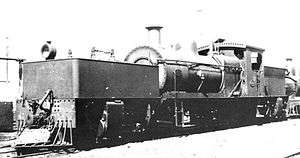WAGR Pm and Pmr classes
The WAGR Pm and Pmr classes were two classes of 4-6-2 tender engine steam locomotives operated by the Western Australian Government Railways (WAGR) between 1950 and the early 1970s.
| WAGR Pm and Pmr classes | |||||||||||||||||||||||||||||||||||
|---|---|---|---|---|---|---|---|---|---|---|---|---|---|---|---|---|---|---|---|---|---|---|---|---|---|---|---|---|---|---|---|---|---|---|---|
.jpg) Pm701 at the Western Australian Rail Transport Museum | |||||||||||||||||||||||||||||||||||
| |||||||||||||||||||||||||||||||||||
| |||||||||||||||||||||||||||||||||||
| |||||||||||||||||||||||||||||||||||
| |||||||||||||||||||||||||||||||||||
History
With the WAGR suffering from a shortage of locomotives and having a backlog of repairs deferred from World War II, authorisation was granted for the construction of 35 4-6-2 locomotives. Initially it was planned that Midland Railway Workshops build 10 with the balance built externally. However capacity constraints at Midland saw the order for the full 35 placed with the North British Locomotive Company, Glasgow.[1][2][3][4]
Nineteen were built as the Pm class with plain bearings on the coupled axles and roller bearings on the carrying axles. The other sixteen were built as the Pmr class with roller bearings on all axles. One Pm was later converted to a Pmr at Midland Railway Workshops.[2][3][4]
All entered service in 1950. Although intended to operate passenger services, their independently sprung driving wheels gave a rough ride meaning they could not maintain schedules, hence they were quickly relegated to fast freight trains on the Eastern Goldfields and Great Southern lines and associated branches. Later they were concentrated on the Great Southern and South Western lines. All were withdrawn between 1970 and 1972.[2][3][4]
Classes list
The numbers and periods in service of each member of the Pm and Pmr classes were as follows:[5]
|
References
Notes
- Turner, Jim (1997). Australian Steam Locomotives 1896-1958. Kenthurst: Kangaroo Press. p. 148. ISBN 086417778X.
- Oberg, Leon (2010). Locomotives of Australia 1850s-2010. Dural: Rosenberg Publishing. p. 237. ISBN 9781921719011.
- Clark, Peter (2012). The Australian Locomotive Guide. Dural: Rosenberg Publishing. p. 60. ISBN 9781922013682.
- Pm Class Steam Locomotive Rail Heritage WA
- Gunzburg 1984, p. 133.
- Pm706 Hotham Valley Railway
- W901 Australian Steam
- Old Northam Railway Station Visit Northam
- Whiteford, David; De Bruin, Charles; Watson, Lindsay; Watson, Neville (1983). Western Australian Preserved Locomotives. Elizabeth: Railmac Publications. p. 14. ISBN 0 949817 19 8.
- November 2013 Hotham Valley Railway
Bibliography
- Gunzburg, Adrian (1968). WAGR Locomotives 1940–1968. Perth: Australian Railway Historical Society (Western Australian Division). pp. 20–21, 47. OCLC 219836193.
- Gunzburg, Adrian (1984). A History of WAGR Steam Locomotives. Perth: Australian Railway Historical Society (Western Australian Division). ISBN 0959969039.
External links
![]()

